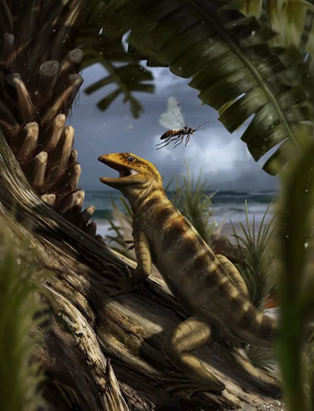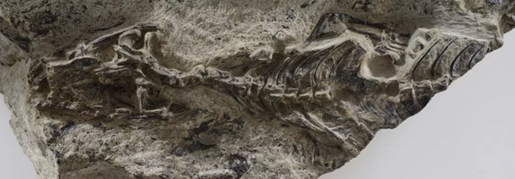最古老的有鳞类动物填补爬行动物起源的空白
来源:《自然》
时间:2018/06/19

约 2.4 亿年前,北意大利 Dolomites 山脉地区的生活图景,Megachirella wachtleri 漫步于植被之中。
Credit: Davide Bonadonna (davide.bonadonna@fastwebnet.it)

保存的 Megachirella wachtleri 标本
Credit: MUSE - Science Museum, Trento, Italy
根据本周《自然》发表的一篇论文 The origin of squamates revealed by a Middle Triassic lizard from the Italian Alps,有鳞类动物(现今包括蛇和蜥蜴在内的动物类群)已知的最古老的祖先生活在中三叠纪——大约 2.4 亿年前。该研究认为有鳞动物的起源和双孔亚纲爬行动物的分化可追溯到 2.52 亿年前二叠纪 / 三叠纪大灭绝之前。这一事件可能为爬行动物谱系内的分化创造新的机会,而不是像以前想象的那样给它们的祖先提供了新的分化机会。
有鳞类动物是陆地脊椎动物种类最多的类群之一,包括蜥蜴和蛇。然而,人们一直未能清晰地理解这一类群的起源,因为已知最古老的化石记录与人们估计的起源时间之间存在 7000 万年的空白;在有关爬行动物系谱图的研究中,有鳞类动物代表不足;解剖学和 DNA 研究提供的最新演化历史存在冲突。
加拿大阿尔伯塔大学的 Tiago Sim?es 及其同事重新检查了以前在意大利阿尔卑斯山发现的Megachirella wachtleri 化石,并将其重新分到包含有鳞类动物的更大范围的分类鳞龙超目。他们使用高分辨率的 CAT 扫描仪,揭示出了化石骨架中以前未被注意到的特征,包括一个小的下颌骨——只见于有鳞动物。除此之外,作者还组建了有史以来最大的化石与现存爬行动物数据集,以评估 Megachirella 在有鳞动物历史中的位置。
研究结果表明,Megachirella是已知最古老的有鳞类动物谱系成员,比侏罗纪时期已知最早的真正的有鳞动物早 7200 万年左右。这一发现有助于填补我们对于有鳞动物和其它爬行动物起源的认知空白,表明它们在二叠纪 / 三叠纪大灭绝后不久就开始分化。(来源:生物360)
The origin of squamates revealed by a Middle Triassic lizard from the Italian Alps
Abstract Modern squamates (lizards, snakes and amphisbaenians) are the world’s most diverse group of tetrapods along with birds1 and have a long evolutionary history, with the oldest known fossils dating from the Middle Jurassic period—168 million years ago2,3,4. The evolutionary origin of squamates is contentious because of several issues: (1) a fossil gap of approximately 70 million years exists between the oldest known fossils and their estimated origin5,6,7; (2) limited sampling of squamates in reptile phylogenies; and (3) conflicts between morphological and molecular hypotheses regarding the origin of crown squamates6,8,9. Here we shed light on these problems by using high-resolution microfocus X-ray computed tomography data from the articulated fossil reptile Megachirella wachtleri (Middle Triassic period, Italian Alps10). We also present a phylogenetic dataset, combining fossils and extant taxa, and morphological and molecular data. We analysed this dataset under different optimality criteria to assess diapsid reptile relationships and the origins of squamates. Our results re-shape the diapsid phylogeny and present evidence that M. wachtleri is the oldest known stem squamate. Megachirella is 75 million years older than the previously known oldest squamate fossils, partially filling the fossil gap in the origin of lizards, and indicates a more gradual acquisition of squamatan features in diapsid evolution than previously thought. For the first time, to our knowledge, morphological and molecular data are in agreement regarding early squamate evolution, with geckoes—and not iguanians—as the earliest crown clade squamates. Divergence time estimates using relaxed combined morphological and molecular clocks show that lepidosaurs and most other diapsids originated before the Permian/Triassic extinction event, indicating that the Triassic was a period of radiation, not origin, for several diapsid lineages.
原文链接:https://www.nature.com/articles/s41586-018-0093-3




